Printing is an essential component of many industries, ranging from publishing and advertising to packaging and fashion. The method of printing chosen can greatly influence the quality, cost, and speed of production, making it crucial to understand the various options available. In this article, we will delve into the different printing methods, discussing what they are suitable for, their advantages and limitations, and how to choose the right one for your needs. We will also explore what to look for when selecting a printing supplier and weigh the pros and cons of investing in your own printing equipment versus outsourcing to a professional supplier.
1. Exploration of Printing Methods
1.1 Offset Lithography

How It Works:
Offset lithography, also known simply as offset printing, is one of the most widely used printing techniques, especially for large-scale commercial printing. The process is based on the repulsion of oil and water. It involves creating a metal plate with the image to be printed. This plate is treated so that the image area attracts ink, while the non-image areas attract water. The inked image is then transferred, or “offset,” from the plate to a rubber blanket, and finally onto the printing surface, usually paper. This indirect process helps protect the printing surface from damage and allows for high-quality printing on a wide range of materials.
Suitable Applications:
Offset lithography is highly versatile and can be used for a variety of applications. It is particularly well-suited for:
- High-Volume Commercial Printing: Books, magazines, newspapers, brochures, and catalogs are often printed using offset lithography due to its efficiency and cost-effectiveness for large print runs.
- High-Quality Image Reproduction: The method is ideal for projects requiring detailed images and consistent colour quality, such as in art prints and high-end marketing materials.
- Packaging: Offset printing is commonly used for folding cartons and packaging where large quantities are needed.
Advantages:
- Cost-Effective for Large Runs: The unit cost of printing decreases significantly as the print run increases, making it economical for high-volume jobs.
- High-Quality Output: Offset lithography produces sharp, clear images and text with excellent colour fidelity and consistency.
- Versatility: It can print on a wide range of surfaces, including paper, cardboard, plastic, and more.
Limitations:
- High Initial Setup Costs: The process requires the creation of plates, which can be costly and time-consuming, making it less suitable for short runs or one-off prints.
- Longer Turnaround Time: The setup process can be complex and time-intensive, leading to longer lead times compared to digital printing.
We are an offset lithographic printing company – you can have a look at our work scope here.
Spectraprint
1.2. Digital Printing
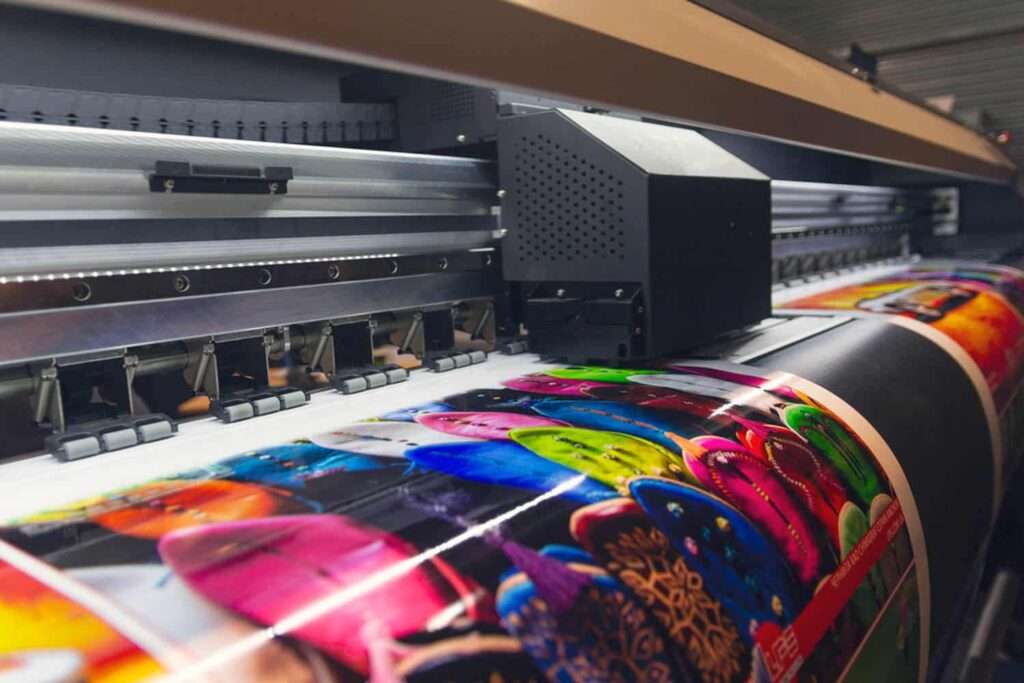
How It Works:
Digital printing is a modern printing method that involves transferring a digital image directly onto the printing surface without the need for intermediate plates or films. The two main types of digital printing are inkjet and laser printing. In inkjet printing, the printer sprays tiny droplets of ink directly onto the paper or other substrate. In laser printing, a laser beam is used to transfer toner (a powder) onto the paper, which is then fused with heat.
Suitable Applications:
Digital printing is ideal for a wide range of applications, particularly where speed and flexibility are required:
- Short-Run Printing: Digital printing is perfect for small print runs, such as for marketing materials, flyers, and business cards, where it is not cost-effective to use offset printing.
- Personalised Printing: Digital printing allows for variable data printing, where each printed piece can be customised with different text, images, or graphics. This is particularly useful for direct mail campaigns and personalised marketing materials.
- On-Demand Printing: With digital printing, you can print exactly what you need, when you need it, reducing waste and storage costs. This is ideal for print-on-demand books, posters, and custom products.
Advantages:
- Lower Setup Costs: Digital printing does not require plates, making it more cost-effective for short runs and quick turnaround projects.
- Speed: The setup process is much faster than traditional methods, allowing for same-day or next-day printing in many cases.
- Flexibility: Digital printing allows for easy updates and changes to designs without incurring significant additional costs.
Limitations:
- Higher Cost per Unit for Large Runs: While digital printing is cost-effective for small quantities, the per-unit cost can be higher than offset printing for large runs.
- Limited Media Options: Digital printers may be limited in the types of paper and other materials they can print on, especially when compared to offset printing.
- colour Accuracy: While digital printing has improved significantly, it may still struggle to match the colour accuracy and consistency of traditional methods like offset lithography.
1.3. Screen Printing

How It Works:
Screen printing, also known as silk screening or serigraphy, is a technique that involves creating a stencil (or screen) and using it to apply layers of ink on the printing surface. The screen is a fine mesh that is stretched over a frame.
Areas of the screen are blocked off to form the desired image, and ink is then pushed through the mesh onto the substrate using a squeegee. Each colour in the design requires a separate screen, which means multi-coloured designs require multiple passes.
Suitable Applications:
Screen printing is particularly popular in the following areas:
- Textiles: Screen printing is the go-to method for printing on fabrics, making it ideal for T-shirts, hoodies, tote bags, and other apparel.
- Promotional Items: It is widely used for printing on a variety of promotional products, such as mugs, pens, and water bottles.
- Posters and Art Prints: Screen printing is favored by artists for creating high-quality, limited-edition art prints and posters with vibrant colours.
Advantages:
- Vibrant colours: Screen printing produces bright, vivid colours that are durable and long-lasting, especially on fabrics.
- Versatility: It can print on a wide range of materials, including textiles, ceramics, metal, wood, and plastic.
- Durability: The thick layers of ink used in screen printing are resistant to fading, making the prints durable even after repeated washing or exposure to the elements.
Limitations:
- Labor-Intensive Setup: The process of preparing screens and setting up for each colour is time-consuming, making it less efficient for short runs.
- Higher Cost for Multi-colour Designs: Each colour requires a separate screen, which can drive up costs for complex, multi-coloured designs.
- Limited Detail: While screen printing excels in colour vibrancy, it may not be suitable for designs that require very fine detail or gradients.
1.4. Gravure Printing
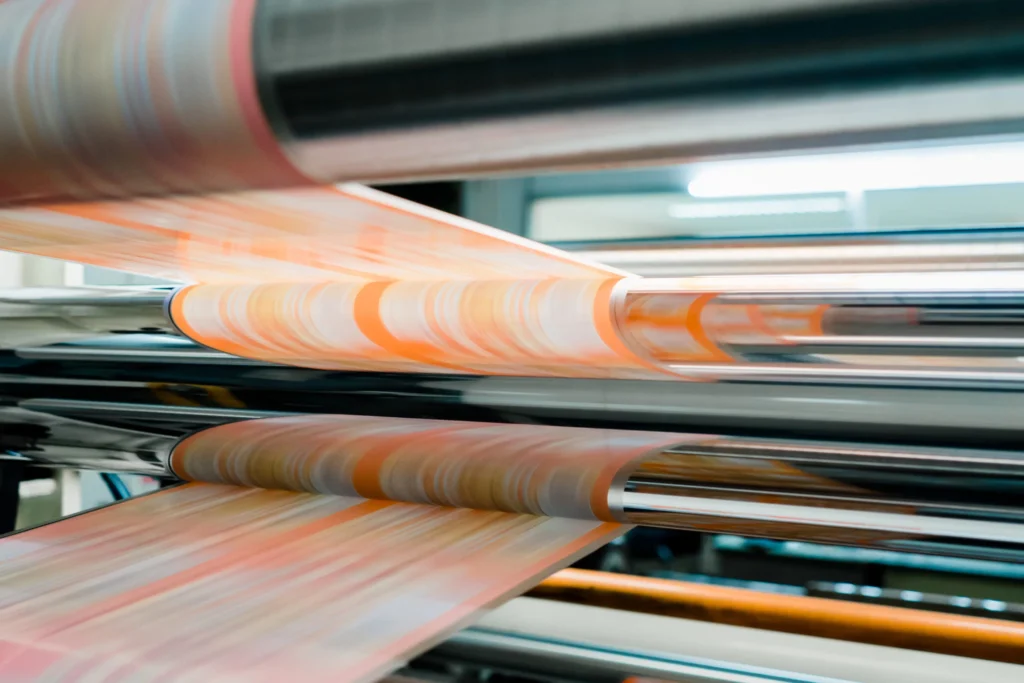
How It Works:
Gravure printing, or rotogravure, is a high-quality printing method that uses a rotary press to transfer ink from engraved cylinders onto the printing surface. The image or text is engraved onto a metal cylinder in the form of tiny cells or wells, which are filled with ink. The excess ink is wiped off the cylinder’s surface, and the ink in the cells is then transferred to the substrate under high pressure.
Suitable Applications:
Gravure printing is used in several high-volume, high-quality applications:
- Packaging: Gravure printing is widely used for printing on packaging materials such as flexible films, foils, and paperboard.
- High-Volume Magazines and Catalogs: Due to its ability to produce high-quality images at high speeds, gravure printing is often used for large-scale magazine and catalog production.
- Decorative Printing: Gravure is also used for printing on decorative materials like wallpaper and laminates.
Advantages:
- High-Speed Production: Gravure printing is capable of producing high-quality prints at extremely fast speeds, making it ideal for large-scale production.
- Excellent Image Quality: The process can produce sharp, detailed images with consistent colour density, making it suitable for high-quality image reproduction.
- Durability: The engraved cylinders used in gravure printing are durable and can be reused for multiple print runs, reducing long-term costs.
Limitations:
- Expensive Setup: The cost of engraving the cylinders is high, making gravure printing cost-effective only for very large print runs.
- Limited Flexibility: Changes to the design require creating new cylinders, which is both costly and time-consuming.
- Environmental Concerns: Gravure printing often involves the use of solvent-based inks, which can have environmental and health implications.
1.5. Flexography
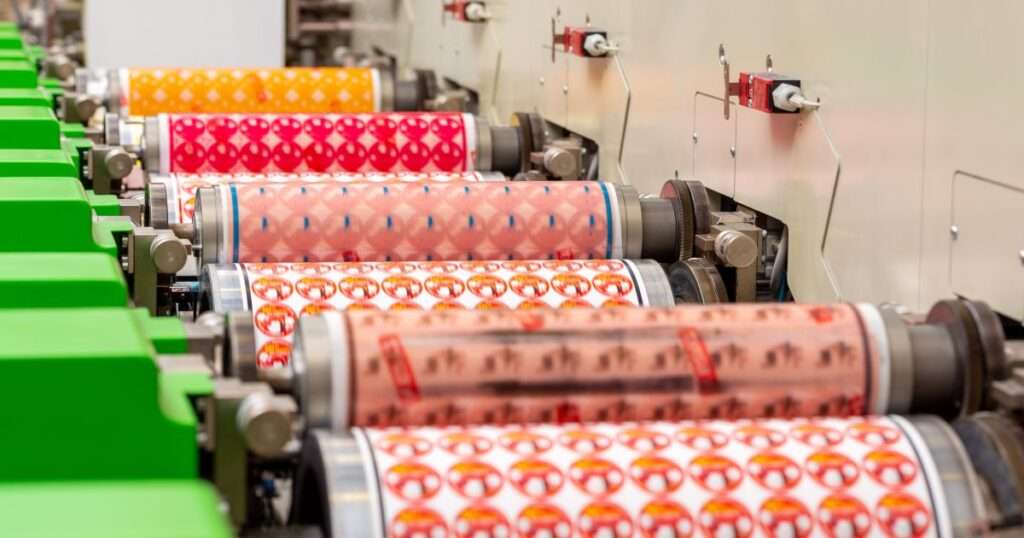
How It Works:
Flexography is a form of relief printing that uses flexible rubber or plastic plates mounted on rotating cylinders. The plates are inked and then pressed against the substrate to transfer the ink. The process is similar to letterpress printing but uses flexible plates, making it more versatile and faster.
Suitable Applications:
Flexography is particularly effective in the following areas:
- Packaging: It is widely used for printing on packaging materials such as corrugated boxes, labels, and bags.
- Newspapers and Magazines: Flexography is used for high-speed printing on newsprint and other absorbent materials.
- Non-Paper Substrates: Flexography is capable of printing on a wide range of materials, including plastic, cellophane, and metallic films, making it ideal for labels, wrappers, and packaging.
Advantages:
- High-Speed Printing: Flexography is one of the fastest printing methods, making it ideal for large-volume print runs.
- Versatility: It can print on a wide variety of substrates, including non-porous materials like plastic and metallic films.
- Cost-Effective: Flexography is economical for large print runs due to its fast production speed and relatively low setup costs compared to methods like gravure printing.
Limitations:
- Lower Image Quality: While flexography has improved significantly, it may not match the image quality of offset or gravure printing, particularly for detailed images.
- Limited colour Reproduction: Flexography can struggle with complex colour gradients and fine details, making it less suitable for high-end image reproduction.
- Plate Wear: The flexible plates used in flexography can wear out over time, particularly when printing large quantities, which can affect print quality.
1.6. 3D Printing

How It Works:
3D printing, or additive manufacturing, builds three-dimensional objects layer by layer from a digital model. The process typically involves laying down successive layers of material until the entire object is formed.
There are several types of 3D printing technologies, including Fused Deposition Modeling (FDM), Stereolithography (SLA), and Selective Laser Sintering (SLS), each using different materials and methods to create objects.
Suitable Applications:
3D printing is revolutionising industries with its versatility and ability to create complex shapes:
- Prototyping: 3D printing is widely used for creating prototypes in industries such as automotive, aerospace, and consumer goods, where rapid iteration and testing are critical.
- Medical Devices: Custom prosthetics, implants, and medical models are increasingly being produced using 3D printing, offering precise customisation and reduced lead times.
- Manufacturing: 3D printing is also used for small-batch production of complex parts and components, particularly in specialised industries like aerospace and medical devices.
Advantages:
- Customisation: 3D printing allows for the creation of custom, complex shapes that would be difficult or impossible to produce with traditional manufacturing methods.
- Material Efficiency: The additive process minimises waste, as material is only used where needed, reducing costs and environmental impact.
- Rapid Prototyping: 3D printing accelerates the design and testing process by enabling quick production of prototypes, reducing time to market.
Limitations:
- Material Constraints: While the range of materials available for 3D printing is expanding, it is still limited compared to traditional manufacturing methods.
- Speed: Printing large objects can be time-consuming, making it less suitable for mass production.
- Cost: The cost of materials and equipment can be high, particularly for industrial-grade 3D printers, limiting its use to specialised applications.
1.7. Sublimation Printing
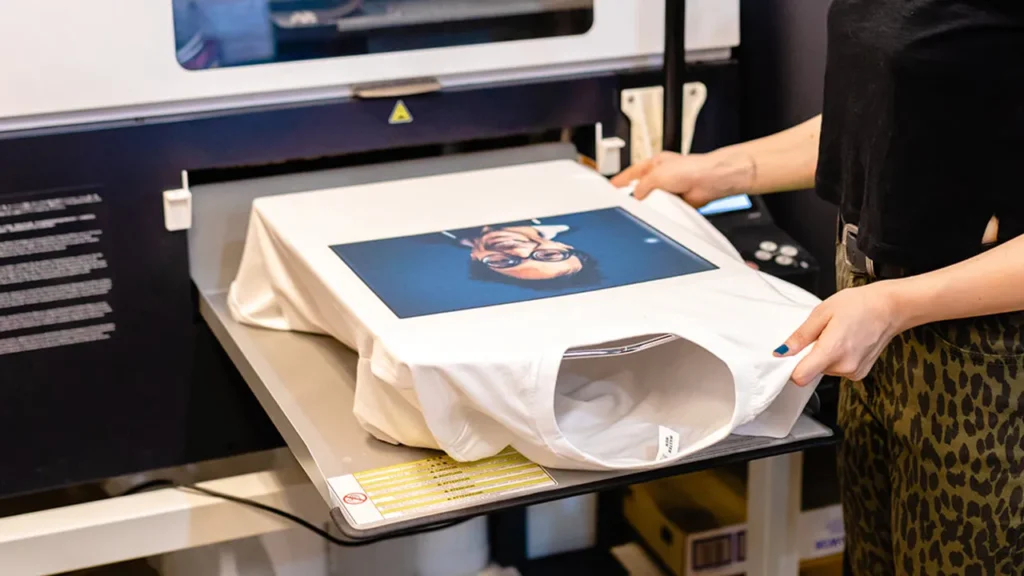
How It Works:
Sublimation printing involves transferring dye onto a material using heat. The process begins by printing the image onto a special transfer paper using sublimation inks. The transfer paper is then placed onto the substrate (such as fabric or coated metal), and heat and pressure are applied. The heat causes the dye to sublimate, turning it into a gas without passing through a liquid phase, and it bonds with the substrate at a molecular level.
Suitable Applications:
Sublimation printing is ideal for applications requiring vibrant, durable images:
- Textiles: Sublimation is commonly used for printing on polyester fabrics, including T-shirts, sportswear, and banners.
- Promotional Products: It is widely used for creating custom items such as mugs, mousepads, and phone cases.
- Photo Gifts: Sublimation is perfect for creating personalised photo gifts and products, where high-quality image reproduction is essential.
Advantages:
- Vibrant, Long-Lasting colours: Sublimation produces bright, vivid colours that are resistant to fading and wear, making them ideal for outdoor or frequently washed items.
- Durable Prints: The dye bonds with the material at a molecular level, so the prints do not crack, peel, or fade over time.
- Wide Range of Products: Sublimation can be used on a variety of surfaces, as long as they are coated for sublimation, offering versatility in product creation.
Limitations:
- Material Limitations: Sublimation is limited to polyester fabrics and specially coated surfaces, making it unsuitable for cotton or other natural fibers.
- Initial Equipment Costs: Sublimation requires specialised printers, inks, and transfer papers, which can be costly to set up.
- colour Gamut: While sublimation is excellent for vibrant colours, it may struggle with certain colour tones, particularly very dark or very light colours.
1.8. Letterpress Printing

How It Works:
Letterpress printing is a relief printing technique where text and images are raised on a plate, inked, and then pressed onto the paper. It is one of the oldest printing methods, dating back to the 15th century, and is valued for its tactile quality and distinctive appearance. The pressure applied during printing creates a debossed effect, where the print is indented into the paper, adding a unique texture and feel.
Suitable Applications:
Letterpress printing is used for high-quality, tactile print products:
- Luxury Stationery: Letterpress is commonly used for wedding invitations, business cards, and other luxury stationery, where a premium, hand-crafted feel is desired.
- Art Prints: Artists and designers often use letterpress for creating limited edition prints, where the tactile quality adds to the aesthetic appeal.
- Specialty Packaging: Letterpress is sometimes used for creating premium packaging, where the embossed or debossed effect adds a sense of exclusivity.
Advantages:
- Distinctive Look and Feel: Letterpress produces a unique, tactile print that is both visually appealing and pleasant to the touch.
- High-Quality Craftsmanship: The process is well-suited to fine details and crisp typography, making it ideal for luxury print products.
- Durable Prints: The indented print is less likely to smudge or wear off, ensuring the longevity of the printed materials.
Limitations:
- Labor-Intensive and Time-Consuming: The process is slow and requires significant manual setup, making it less efficient for large print runs.
- High Cost for Small Runs: Letterpress is best suited for small batches due to the time and skill required, which can drive up costs for short runs.
- Limited colour Range: While letterpress can produce beautiful prints, it is often limited to one or two colours due to the complexity and cost of multi-colour setups.
1.9. Rotogravure Printing

How It Works:
Rotogravure is a type of gravure printing that uses a rotary press to transfer ink from engraved cylinders onto the substrate. The image is engraved onto the cylinder in the form of tiny cells, and as the cylinder rotates, it picks up ink from an ink fountain and transfers it to the paper or other material. The excess ink is wiped off the cylinder surface before the substrate is printed.
Suitable Applications:
Rotogravure is ideal for high-volume, high-quality printing applications:
- Magazines and Catalogs: Rotogravure is often used for printing large volumes of magazines, catalogs, and other periodicals where image quality is paramount.
- Packaging: It is widely used in the packaging industry for printing on materials like cellophane, polyethylene, and foil, particularly for food packaging.
- Decorative Printing: Rotogravure is used for printing wallpapers, laminates, and other decorative materials with intricate patterns and high-quality finishes.
Advantages:
- High-Speed Production: Rotogravure is capable of very high-speed printing, making it ideal for large-scale production.
- Excellent Image Quality: The process produces sharp, detailed images with consistent colour density, making it suitable for high-quality image reproduction.
- Durability: The engraved cylinders are durable and can be reused for multiple print runs, reducing long-term costs.
Limitations:
- High Initial Costs: The cost of engraving the cylinders is high, making rotogravure printing cost-effective only for very large print runs.
- Limited Flexibility: Changes to the design require creating new cylinders, which is both costly and time-consuming.
- Environmental Impact: Rotogravure printing often involves solvent-based inks, which can have environmental and health implications.
1.10. Thermography
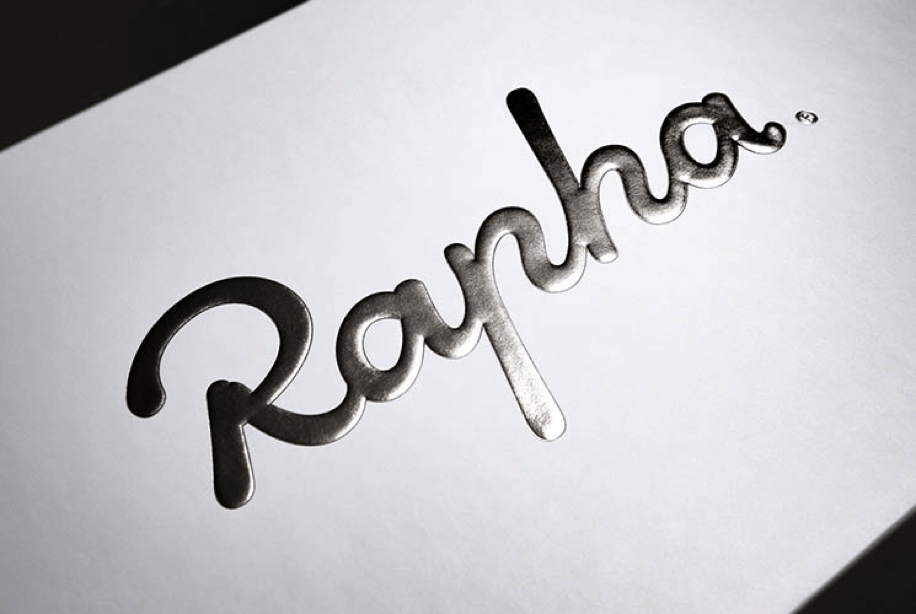
How It Works:
Thermography is a printing process that creates raised, glossy images on paper by applying a resin powder to wet ink and then heating it. The heat causes the resin to melt and fuse with the ink, resulting in a raised print that has a shiny, embossed effect. Thermography is often used as an alternative to engraving or embossing because it produces similar results at a lower cost.
Suitable Applications:
Thermography is commonly used for high-end printed materials:
- Business Cards: Thermography is often used to create elegant, raised text on business cards.
- Invitations: It is a popular choice for wedding invitations, event announcements, and other special occasion stationery.
- Certificates: Thermography is used for printing formal certificates, awards, and diplomas where a professional, raised finish is desired.
Advantages:
- Elegant Finish: Thermography creates a raised, glossy effect that adds a premium feel to printed materials.
- Cost-Effective: It offers a more affordable alternative to traditional engraving or embossing while still delivering a similar appearance.
- Durable Prints: The raised text is more resistant to smudging and wear, ensuring the longevity of the print.
Limitations:
- Limited colour Range: Thermography works best with dark ink on light paper, limiting the range of colour options.
- specialised Equipment: The process requires specific machines and materials, which can be costly for small operations.
- Not Suitable for All Designs: While thermography excels with text and simple designs, it may not be the best choice for intricate or highly detailed images.
1.11. Pad Printing

How It Works:
Pad printing is a unique printing process that involves transferring ink from an etched plate onto a silicone pad, which is then used to press the ink onto the substrate. The silicone pad’s flexibility allows it to conform to irregular shapes and surfaces, making pad printing ideal for printing on items that are not flat or have complex geometries.
Suitable Applications:
Pad printing is widely used in the following areas:
- Promotional Products: Pad printing is commonly used for printing logos and designs on promotional items such as pens, keychains, and golf balls.
- Electronics: It is ideal for printing on small electronic components, including buttons, switches, and dials.
- Medical Devices: Pad printing is often used for branding and labeling on medical instruments, devices, and components where precision is essential.
Advantages:
- Versatility: Pad printing can print on a variety of shapes and surfaces, including curved and textured materials, making it suitable for complex geometries.
- Precision: The process is capable of printing fine details and small text with high accuracy, making it ideal for applications where precision is critical.
- Cost-Effective for Small Runs: Pad printing is economical for small to medium print runs, especially on specialised or irregularly shaped products.
Limitations:
- Limited to Simple Designs: Pad printing is best suited for single or two-colour prints; complex designs or multi-colour prints require multiple passes, increasing time and cost.
- Not Ideal for Large Surfaces: Pad printing is better suited for small areas rather than large-scale printing, as the size of the silicone pad can limit the size of the print.
- Setup Costs: While pad printing is economical for small runs, the setup costs for creating the etched plates and preparing the pads can be high, particularly for multi-colour designs.
2. Choosing the Right Printing Supplier
When selecting a printing supplier, several factors need to be considered to ensure you receive the best quality, service, and value for your money. Here’s what you should look for:
2.1. Quality and Consistency
The quality of the print job is paramount, and consistency across print runs is equally important. Here’s how to assess this:
- Sample Work: Always ask for samples of previous work to evaluate the supplier’s print quality. Check for sharpness, colour accuracy, and consistency in the samples.
- Equipment Used: The type of equipment a supplier uses can significantly impact the quality of the final product. Ensure the supplier uses modern, well-maintained machinery that is capable of producing high-quality prints consistently.
- Colour Management: Inquire about the supplier’s colour management process. Accurate colour reproduction is essential, especially for branding materials, so make sure the supplier has a robust system in place for maintaining colour consistency across print runs.
2.2. Turnaround Time
The ability to meet deadlines is critical, especially if your project is time-sensitive. Consider the following:
- Lead Times: Understand the typical lead time for orders. Ask about their production schedule and how it might affect your project. Suppliers with a busy schedule might not be able to accommodate rush jobs without sacrificing quality.
- Flexibility: Some suppliers offer rush services for an additional fee. Determine if the supplier can accommodate last-minute requests or changes without compromising the quality of the final product.
2.3. Cost Considerations
Cost is always a factor, but it should not be the only consideration. Here’s how to assess pricing:
- Pricing Structure: Compare pricing across multiple suppliers. Be sure to understand the breakdown of costs, including setup fees, unit costs, and any discounts available for bulk orders.
- Transparency: Ensure that all costs are clearly outlined in the supplier’s quote. Watch out for hidden fees, such as charges for proofs, shipping, or additional services.
- Value vs. Cost: Sometimes, the lowest price may not offer the best value. Consider the quality of the work, turnaround time, and level of customer service when evaluating quotes.
2.4. Customer Service and Reputation
Good customer service can make the difference between a smooth, successful print job and a frustrating experience. Here’s what to look for:
- Communication: Choose a supplier who communicates clearly and promptly. They should be responsive to inquiries and provide detailed information about their processes, timelines, and costs.
- Problem Resolution: Assess the supplier’s approach to handling issues or errors. Do they have a clear process for dealing with mistakes, and are they willing to make things right if problems arise?
- Reputation: Look for online reviews and testimonials from previous clients. A supplier with a strong reputation and positive feedback is more likely to deliver quality work consistently.
- Experience: Consider the supplier’s experience in your specific industry or type of print job. A supplier with a track record in similar projects will be better equipped to meet your needs.
2.5. Location and Logistics
While the location of your supplier might not seem important at first, it can affect both cost and turnaround time:
- Proximity to Your Business: A supplier located nearby can reduce shipping costs and transit times. This can be especially important for large or heavy print jobs where shipping costs can add up quickly.
- Shipping and Delivery Options: Ensure the supplier offers reliable shipping and delivery options that meet your needs. Some suppliers may offer free local delivery or discounted rates for bulk orders.
3. Cost-Effectiveness: In-House Printing vs. Using a Supplier
Deciding whether to invest in your own printing equipment or use a professional supplier depends on several factors, including cost, volume, and the specific needs of your business.
3.1. Initial Investment and Long-Term Costs
Investing in your own printing equipment involves significant upfront costs, including the purchase of the printer, software, and any necessary accessories. You’ll also need to factor in ongoing expenses such as ink, paper, maintenance, and repairs.
- High-End Equipment Costs: Industrial-grade printers, such as those used for offset or large-format printing, can be prohibitively expensive for small businesses. Even high-quality digital printers can represent a significant investment.
- Maintenance and Consumables: Regular maintenance is essential to keep your printer in top working condition, and consumables like ink and paper can add up quickly, particularly if you print in large volumes.
3.2. Volume and Frequency Considerations
The volume and frequency of your printing needs are critical factors in determining whether it’s more cost-effective to print in-house or outsource:
- In-House Printing: If your business has consistent, high-volume printing needs, investing in your own equipment may be more cost-effective in the long run. In-house printing allows for greater control over the process, including quality, scheduling, and cost management.
- Using a Supplier: For businesses with infrequent or low-volume printing needs, it may be more practical and cost-effective to outsource. Suppliers can offer economies of scale, reducing the per-unit cost for large print runs. They also take care of maintenance, upgrades, and other expenses associated with owning printing equipment.
3.3. Quality Control and Expertise
Quality control is another important consideration when deciding whether to print in-house or use a supplier:
- In-House Printing: Managing quality in-house requires skilled operators who can handle the equipment and ensure consistent output. You’ll also need to invest in training and quality control processes to achieve the desired results.
- Using a Supplier: Professional suppliers have the expertise and experience to deliver high-quality results consistently. They also have access to advanced equipment and materials that may be beyond the reach of a small business, allowing them to produce superior prints.
3.4. Case Studies
Here are some examples to illustrate the cost-effectiveness of in-house printing versus using a supplier:
Case Study 1: A Small Marketing Agency
A small marketing agency frequently prints custom brochures, flyers, and business cards for their clients. They found that investing in a high-quality digital printer allowed them to reduce costs and improve turnaround times, as they could print materials in-house and make adjustments on the fly. The initial investment paid off within the first year, and the agency was able to offer more competitive pricing to their clients.
Case Study 2: A Retail Business
A retail business that occasionally needs promotional materials for seasonal sales and events chose to outsource their printing to a supplier. The supplier offered competitive rates and handled all aspects of the printing process, including design adjustments, proofing, and delivery. The business found that outsourcing allowed them to focus on their core operations while still receiving high-quality print materials as needed.
Conclusion
Choosing the right printing method and deciding whether to invest in your own printing equipment or use a supplier are crucial decisions that can significantly impact your business. Understanding the strengths and limitations of each printing method is essential for selecting the one that best meets your needs, whether you’re looking for high-volume production, high-quality image reproduction, or specialised printing on unique materials.
When selecting a printing supplier, it’s important to consider factors such as quality, turnaround time, cost, customer service, and location. A reliable supplier can help you achieve your desired results while allowing you to focus on other aspects of your business.
For businesses with high-volume or specialised printing needs, investing in your own printer may be cost-effective and provide greater control over the printing process. However, for many businesses, especially those with infrequent or low-volume printing needs, outsourcing to a professional supplier remains the more practical and flexible option.
By carefully considering your specific requirements, you can make informed decisions that enhance the quality and efficiency of your printed materials, ultimately supporting the growth and success of your business.
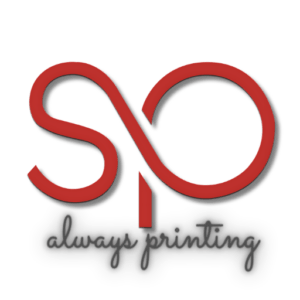

Leave a Reply